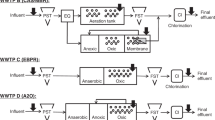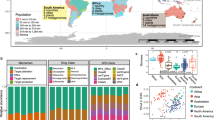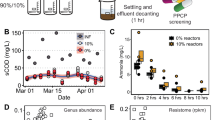Abstract
There is increasing evidence that human activity, and especially the resulting effluent, has a major role in the dissemination of bacterial antibiotic-resistance determinants in the environment. Hospitals are the major antibiotic consumers and thus facilitate the spread of antibiotic resistance. Questions are increasingly being raised about the management of hospital effluents, but their involvement in antibiotic-resistance dissemination has never been assessed. Integrons are a paradigm of genetic transfer between the environmental resistome and both commensal and pathogenic bacteria. In order to assess the impact of hospital activities on antibiotic-resistance dissemination in the environment, we monitored integrons and their gene cassettes in hospital effluents, and their release in the environment. We found that bacterial communities present in a hospital effluent contained a high proportion of integrons. In terms of both their gene cassette diversity and gene cassette arrays, the urban effluent and municipal wastewater treatment plant (WWTP) influent were most similar, whereas the hospital effluent and recirculation sludge exhibited very specific patterns. We found that anthropogenic activities led to the release of abundant integrons and antibiotic-resistance gene cassettes, but we observed no specific impact of hospital activities on the receiving environment. Furthermore, although the WWTP did not reduce the normalized integron copy number, it reduced the diversity of gene cassette arrays contained in the raw wastewater, underlining the effect of the biological treatment on the anthropogenic integron pool arriving at the WWTP.
Similar content being viewed by others
Log in or create a free account to read this content
Gain free access to this article, as well as selected content from this journal and more on nature.com
or
Accession codes
References
Amann RI, Ludwig W, Schleifer KH . (1995). Phylogenetic identification and in situ detection of individual microbial cells without cultivation. Microbiol Rev 59: 143–169.
Baquero F, Martínez JL, Cantón R . (2008). Antibiotics and antibiotic resistance in water environments. Curr Opin Biotechnol 19: 260–265.
Baquero F, Tedim AP, Coque TM . (2013). Antibiotic resistance shaping multi-level population biology of bacteria. Front Microbiol 4: 15.
Barraud O, Baclet MC, Denis F, Ploy M-C . (2010). Quantitative multiplex real-time PCR for detecting class 1, 2 and 3 integrons. J Antimicrob Chemother 65: 1642–1645.
Barraud O, Casellas M, Dagot C, Ploy M-C . (2013). An antibiotic-resistant class 3 integron in an Enterobacter cloacae isolate from hospital effluent. Clin Microbiol Infect 19: E306–E308.
Binh CTT, Heuer H, Kaupenjohann M, Smalla K . (2009). Diverse aadA gene cassettes on class 1 integrons introduced into soil via spread manure. Res Microbiol 160: 427–433.
Blázquez J, Couce A, Rodríguez-Beltrán J, Rodríguez-Rojas A . (2012). Antimicrobials as promoters of genetic variation. Curr Opin Microbiol 15: 561–569.
Bruchmann J, Kirchen S, Schwartz T . (2013). Sub-inhibitory concentrations of antibiotics and wastewater influencing biofilm formation and gene expression of multi-resistant Pseudomonas aeruginosa wastewater isolates. Environ Sci Pollut Res Int 20: 3539–3549.
Cambray G, Guerout AM, Mazel D . (2010). Integrons. Annu Rev Genet 44: 141–166.
Cavalié P . (2012). Trends in antibiotic use in France in 2000−2010. Bull épidémiol hebd 42–43: 480–485.
Elsaied H, Stokes HW, Kitamura K, Kurusu Y, Kamagata Y, Maruyama A . (2011). Marine integrons containing novel integrase genes, attachment sites, attI, and associated gene cassettes in polluted sediments from Suez and Tokyo Bays. ISME J 5: 1162–1177.
Ferreira da Silva M, Vaz-Moreira I, Gonzalez Pajuelo M, Nunes OC, Manaia CM . (2007). Antimicrobial resistance patterns in Enterobacteriaceae isolated from an urban wastewater treatment plant. FEMS Microbiol Ecol 60: 166–176.
Forsberg KJ, Reyes A, Wang B, Selleck EM, Sommer MOA, Dantas G . (2012). The shared antibiotic resistome of soil bacteria and human pathogens. Science 337: 1107–1111.
Gaze WH, Abdouslam N, Hawkey PM, Wellington EMH . (2005). Incidence of class 1 integrons in a quaternary ammonium compound-polluted environment. Antimicrob Agents Chemother 49: 1802–1807.
Gaze WH, Zhang L, Abdouslam NA, Hawkey PM, Calvo-Bado L, Royle J et al (2011). Impacts of anthropogenic activity on the ecology of class 1 integrons and integron-associated genes in the environment. ISME J 5: 1253–1261.
Gillings MR, Boucher Y, Labbate M, Holmes A, Krishnan S, Holley M et al (2008a). The evolution of class 1 integrons and the rise of antibiotic resistance. J Bacteriol 190: 5095–5100.
Gillings MR, Xuejun D, Hardwick SA, Holley MP, Stokes HW . (2008b). Gene cassettes encoding resistance to quaternary ammonium compounds: a role in the origin of clinical class 1 integrons? ISME J 3: 209–215.
Guerin E, Cambray G, Sanchez-Alberola N, Campoy S, Erill I, Da Re S et al (2009). The SOS response controls integron recombination. Science 324: 1034.
Hardwick SA, Stokes HW, Findlay S, Taylor M, Gillings MR . (2008). Quantification of class 1 integron abundance in natural environments using real-time quantitative PCR. FEMS Microbiol Lett 278: 207–212.
Klappenbach JA, Saxman PR, Cole JR, Schmidt TM . (2001). rrndb: the ribosomal RNA operon copy number database. Nucleic Acids Res 29: 181–184.
Koenig JE, Boucher Y, Charlebois RL, Nesbø C, Zhaxybayeva O, Bapteste E et al (2008). Integron-associated gene cassettes in Halifax Harbour: assessment of a mobile gene pool in marine sediments. Environ Microbiol 10: 1024–1038.
Koenig JE, Bourne DG, Curtis B, Dlutek M, Stokes HW, Doolittle WF et al (2011). Coral-mucus-associated Vibrio integrons in the Great Barrier Reef: genomic hotspots for environmental adaptation. ISME J 5: 962–972.
Kümmerer K . (2001). Drugs in the environment: emission of drugs, diagnostic aids and disinfectants into wastewater by hospitals in relation to other sources—a review. Chemosphere 45: 957–969.
Lapara TM, Burch TR, McNamara PJ, Tan DT, Yan M, Eichmiller JJ . (2011). Tertiary-treated municipal wastewater is a significant point source of antibiotic resistance genes into Duluth-Superior harbor. Environ Sci Technol 45: 9543–9549.
Larouche A, Roy PH . (2011). Effect of attC structure on cassette excision by integron integrases. Mob DNA 2: 3.
LeRoux F, Zouine M, Chakroun N, Binesse J, Saulnier D, Bouchier C et al (2009). Genome sequence of Vibrio splendidus: an abundant planctonic marine species with a large genotypic diversity. Environ Microbiol 11: 1959–1970.
Levesque C, Piche L, Larose C, Roy PH . (1995). PCR mapping of integrons reveals several novel combinations of resistance genes. Antimicrob Agents Chemother 39: 185–191.
Łuczkiewicz A, Jankowska K, Fudala-Książek S, Olańczuk-Neyman K . (2010). Antimicrobial resistance of fecal indicators in municipal wastewater treatment plant. Water Res 44: 5089–5097.
Martínez JL . (2009). Environmental pollution by antibiotics and by antibiotic resistance determinants. Environ Pollut 157: 2893–2902.
Mazel D . (2006). Integrons: agents of bacterial evolution. Nat Rev Microbiol 4: 608–620.
Moura A, Henriques I, Smalla K, Correia A . (2010). Wastewater bacterial communities bring together broad-host range plasmids, integrons and a wide diversity of uncharacterized gene cassettes. Res Microbiol 161: 58–66.
Novo A, Manaia C . (2010). Factors influencing antibiotic resistance burden in municipal wastewater treatment plants. Appl Microbiol Biotechnol 87: 1157–1166.
Partridge SR, Tsafnat G, Coiera E, Iredell JR . (2009). Gene cassettes and cassette arrays in mobile resistance integrons. FEMS Microbiol Rev 33: 757–784.
Poirel L, Brinas L, Verlinde A, Ide L, Nordmann P . (2005). BEL-1, a novel clavulanic acid-inhibited extended-spectrum β-lactamase, and the class 1 integron In120 in Pseudomonas aeruginosa. Antimicrob Agents Chemother 49: 3743–3748.
Poirel L, Weldhagen GF, Naas T, De Champs C, Dove MG, Nordmann P . (2001). GES-2, a class A β-lactamase from Pseudomonas aeruginosa with increased hydrolysis of imipenem. Antimicrob Agents Chemother 45: 2598–2603.
Rizzo L, Manaia C, Merlin C, Schwartz T, Dagot C, Ploy MC et al (2013). Urban wastewater treatment plants as hotspots for antibiotic resistant bacteria and genes spread into the environment: a review. Sci Total Environ 447C: 345–360.
Rodríguez-Rojas A, Rodríguez-Beltrán J, Couce A, Blázquez J . (2013). Antibiotics and antibiotic resistance: a bitter fight against evolution. Int J Med Microbiol 303: 293–297.
Rosewarne CP, Pettigrove V, Stokes HW, Parsons YM . (2010). Class 1 integrons in benthic bacterial communities: abundance, association with Tn402-like transposition modules and evidence for coselection with heavy-metal resistance. FEMS Microbiol Ecol 72: 35–46.
Rowe-Magnus DA, Guerout A-M, Mazel D . (2002). Bacterial resistance evolution by recruitment of super-integron gene cassettes. Mol Microbiol 43: 1657–1669.
Stalder T, Alrhmoun M, Louvet J-N, Casellas M, Maftah C, Carrion C et al (2013). Dynamic assessment of the floc morphology, bacterial diversity, and integron content of an activated sludge reactor processing hospital effluent. Environ Sci Technol 47: 7909–7917.
Stalder T, Barraud O, Casellas M, Dagot C, Ploy MC . (2012). Integron involvement in environmental spread of antibiotic resistance. Front Microbiol 3: 119.
Stokes HW, Gillings MR . (2011). Gene flow, mobile genetic elements and the recruitment of antibiotic resistance genes into Gram-negative pathogens. FEMS Microbiol Rev 35: 790–819.
Stokes HW, Hall RM . (1989). A novel family of potentially mobile DNA elements encoding site-specific gene-integration functions: integrons. Mol Microbiol 3: 1669–1683.
Szczepanowski R, Linke B, Krahn I, Gartemann KH, Gützkow T, Eichler W et al (2009). Detection of 140 clinically relevant antibiotic-resistance genes in the plasmid metagenome of wastewater treatment plant bacteria showing reduced susceptibility to selected antibiotics. Microbiology 155: 2306–2319.
Uyaguari MI, Fichot EB, Scott GI, Norman RS . (2011). Characterization and quantitation of a novel β-lactamase gene found in a wastewater treatment facility and the surrounding coastal ecosystem. Appl Environ Microbiol 77: 8226–8233.
Wellington EMH, Boxall ABA, Cross P, Feil EJ, Gaze WH, Hawkey PM et al (2013). The role of the natural environment in the emergence of antibiotic resistance in Gram-negative bacteria. Lancet Infect Dis 13: 155–165.
Wright MS, Baker-Austin C, Lindell AH, Stepanauskas R, Stokes HW, McArthur JV . (2008). Influence of industrial contamination on mobile genetic elements: class 1 integron abundance and gene cassette structure in aquatic bacterial communities. ISME J 2: 417–428.
Zhang X, Wu B, Zhang Y, Zhang T, Yang L, Fang HHP et al (2009a). Class 1 integronase gene and tetracycline resistance genes tetA and tetC in different water environments of Jiangsu Province, China. Ecotoxicology 18: 652–660.
Zhang XX, Zhang T, Zhang M, Fang HHP, Cheng SP . (2009b). Characterization and quantification of class 1 integrons and associated gene cassettes in sewage treatment plants. Appl Microbiol Biotechnol 82: 1169–1177.
Acknowledgements
This work was supported by the European INTEREG program PILLS, the Limousin region and the CPAM Haute-Vienne. We thank the city and hospital of Limoges, as well as Didier Mazel and Sandra Da-Re for their critical reading of the manuscript and Armelle Marie-Daragon for providing data on antibiotic consumption. Thibault Stalder was funded by grants from the Limousin region.
Author information
Authors and Affiliations
Corresponding author
Ethics declarations
Competing interests
The authors declare no conflict of interest.
Additional information
Supplementary Information accompanies this paper on The ISME Journal website
Supplementary information
Rights and permissions
About this article
Cite this article
Stalder, T., Barraud, O., Jové, T. et al. Quantitative and qualitative impact of hospital effluent on dissemination of the integron pool. ISME J 8, 768–777 (2014). https://doi.org/10.1038/ismej.2013.189
Received:
Revised:
Accepted:
Published:
Issue date:
DOI: https://doi.org/10.1038/ismej.2013.189
Keywords
This article is cited by
-
Wastewater treatment from a typical multisystem hospital using chemically modified banana peels: Taguchi parametric optimization and characterization
Applied Water Science (2024)
-
Biotic and abiotic factors distinctly drive contrasting biogeographic patterns between phyllosphere and soil resistomes in natural ecosystems
ISME Communications (2021)
-
Antibiotic Resistance in Pseudomonas spp. Through the Urban Water Cycle
Current Microbiology (2021)
-
Distribution of genetic elements associated with antibiotic resistance in treated and untreated animal husbandry waste and wastewater
Environmental Science and Pollution Research (2021)
-
Vertical and horizontal distributions of clinical antibiotic resistance genes and bacterial communities in Danjiangkou Reservoir, China
Environmental Science and Pollution Research (2021)



